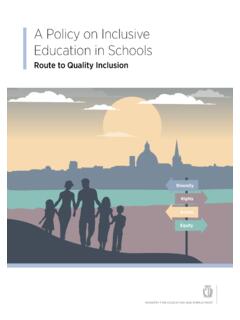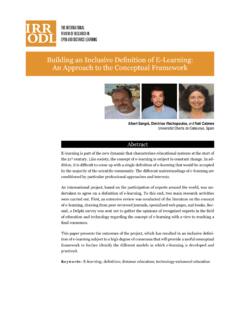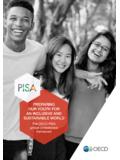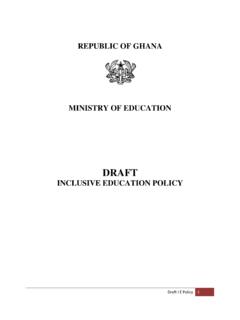Transcription of A National Inclusive Education Framework
1 A National Inclusive Education Framework Diversity Rights Access Equity A National Inclusive Education Framework Published in 2019. List of Contributors Ms Josanne Ghirxi Assistant Director Inclusive Education , NSSS. Ms Darlene Borg Assistant Director Special Education , NSSS. Dr Jonathan Camenzuli Education Officer Inclusive Education , NSSS. Dr Maria Pace Education Officer Inclusive Education , NSSS. Ms Amanda Schembri Muscat Education Officer Inclusive Education , NSSS. Feedback was also provided by Profs Mark Borg, who always contributed extremely valuable critique that improved the document considerably.
2 The contributors have also received continuous support and encouragement from Ms Maria Mc Namara (DG DES) and Ms Sandra Cortis (Director NSSS). Invaluable support was provided by Mr Oliver Scicluna (Commissioner for the Rights of Persons with Disability). Esteemed guidance was also provided by Dr Amanda Watkins on behalf of the European Agency for Special Needs and Inclusive Education . Feedback was also provided by: Dr Jacqueline Vanhear (Director Quality Assurance). Mr Raymond J Camilleri (Head, School Internal Review and Support Unit). The Council of the College Principals Mr Dunstan Hamilton (EO PSCD).
3 Profs Paul Bartolo Profs Sandro Caruana Dr Colin Calleja Bord Konsultattiv g all-Edukazzjoni Obbligatorja The Human Rights and Integration Directorate (HRID). Malta Federation of Persons with a Disability (MFODP). National Commission for the Promotion of Equality (NCPE). 4. Contents 1 Terminology and acronyms 6. 2 Executive summary 9. 3 Introduction to the Framework 11. 4 Principles of the Framework 13. 5 Action on different forms of barriers 14. 6 Structure of the Framework 20. 7 Literature underpinning development of Framework 44. 8 References 48.
4 5. Terminology and Acronyms 1. TERMINOLOGY. Barriers Refers to factors in a person's environment that, through their absence or presence, limit functioning and create disability (WHO, 2001). College Refers to a cluster of primary, middle and secondary schools in the State Education Sector in Malta. Continuous Professional Refers to training of educators in order to update and enhance their knowledge and skills. Education Disability Refers to a long-term physical, mental, intellectual or sensory impairment which in interaction with various barriers may hinder one's full and effective participation in society on an equal basis with others (Equal Opportunities Act, Act XXIV of 2016).
5 Diversity Refers to differences or dimensions that can be used to differentiate groups and individual persons from one another, including body appearance, ethnicity, gender, age, National origin, disability, sexual orientation, gender identity, gender expression, sex characteristics, social class, level of Education , religion, work experiences, life styles and cultures and being sensitive to emerging diversities and needs. Educators Refers to members of the Senior Management Team (SMT), Teachers, Kindergarten Educators and Learning Support Educators (LSEs) working with learners in educational settings including Child Care Centres, Kindergarten, Primary, Middle, Secondary and Post-Secondary Schools, Resource Centres, Learning Support Centres, Alternative Learning Centres and any other educational institution.
6 Equity Equity is about ensuring that there is a concern with fairness, such that the Education of all learners is seen as having equal importance (UNESCO, ). High quality Education Refers to a system that serves all learners in such a way that it prepares them for their future. In so doing it makes provisions for a relevant curriculum, appropriate assessment, high quality teaching, collegial leadership and accountability to peers and families. High quality Education has high expectations for all. Inclusive Education Refers to the valuing and acceptance of diversity, to its value and the rights of learners to not only attend mainstream schools, but also to belong as valued members through active participation and the elimination of the barriers limiting the participation and achievement of all learners, respect diverse needs, abilities and characteristics.
7 Inclusive Learning-Friendly Refers to a learning environment which provides the optimal conditions for effective learning and Environment (ILFE) teaching to take place. Such an environment welcomes, nurtures and educates all learners regardless of their gender, physical, intellectual, social, emotional, linguistic or other characteristics (unesco, 2015). Individualised Education Refers to the planning for individual learner needs and the process of planning, implementing and Plans (IEP) evaluating a curriculum programme as well as the holistic development of the learner.
8 6. Inter-cultural Education Refers to any form of Education that acknowledges and fosters cultural pluralism, culture in the broadest possible sense, encompassing differences in ethnicity, gender, age, National origin, disability, sexual orientation, gender identity, gender expression, sex characteristics, social class, religion and Education . It is founded on the principle of educational equity for all learners. Learners Refers to all children who are attending Child Care Centres, Kindergarten, Primary, Middle, Secondary and Post-Secondary Schools, Resource Centres, Learning Support Centres, Alternative Learning Centres and any other educational institution.
9 This policy uses the term learner because this term places a certain degree of responsibility for learning on behalf of the individual (Bray & McClaskey, 2014). However, there are many other factors that influence learning and the role of educators and learners together can lead to more effective outcomes. Parent Refers to the biological or legal guardians of the learner attending the school. School Refers to all State, Church and Independent Child care centres, Primary schools, Middle and Secondary schools, and other educational centres. School community Refers to the Senior Management Team, educators, support professionals and staff members who work in a school, the learners who attend the school and their parents and families, broader social community and organizations that have a stake in the Education of learners.
10 School Management Team Refers to school leaders (Head of School and Assistant Head/s of School) working in a particular school, (SMT) also in liaison with Head of Departments and Head of Department Inclusion. This term also refers to Learning Support Centre Coordinators. Support structures and Refers to specialised settings and specialised professionals (college based or private) who offer services services to learners through screening, early intervention and throughout compulsory schooling. Ideally, these services are offered in class with professionals in consultation with educators, working in transdisciplinary teams.





